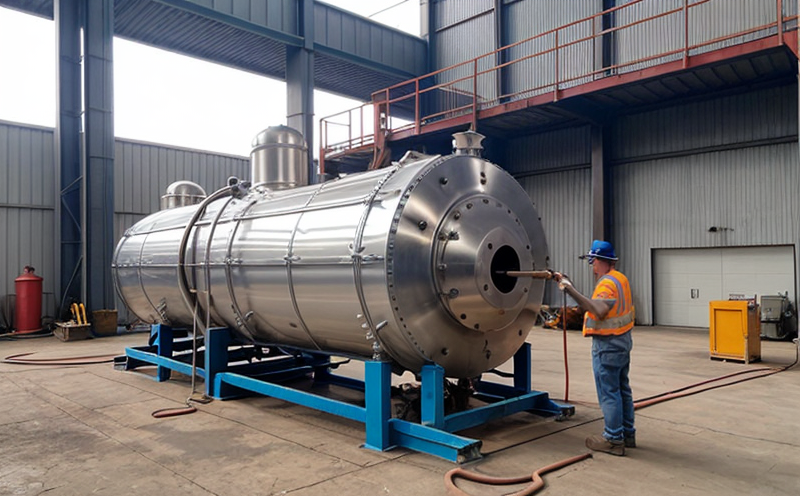Boiler drum inspection
The boiler drum is a critical component in a boiler system, responsible for holding water and steam. Its integrity directly impacts the efficiency and safety of power generation processes. Routine inspections are essential to ensure that the boiler drum remains free from defects that could lead to accidents or operational inefficiencies.
Boiler drums are subject to high pressures and temperatures, which can cause various types of degradation over time. Common issues include corrosion, erosion, and stress-induced cracking. Regular inspections help in identifying these potential hazards early on, allowing for timely maintenance or replacement if necessary.
The inspection process typically involves a combination of non-destructive testing (NDT) methods such as ultrasonic testing, radiographic examination, and visual inspection. These tests are conducted by experienced technicians who use advanced equipment to assess the structural integrity of the boiler drum. The findings from these inspections are meticulously documented and reported.
The primary objective of a boiler drum inspection is not just to detect current issues but also to predict future failures based on historical data and material properties. By understanding the specific conditions under which the boiler operates, inspectors can tailor their approach to ensure comprehensive coverage of all critical areas.
During an inspection, it is crucial to follow strict safety protocols due to the hazardous environment where boilers are typically found. This includes wearing appropriate personal protective equipment (PPE), ensuring proper ventilation, and having emergency response plans in place. Compliance with international standards such as ASME (American Society of Mechanical Engineers) codes ensures that inspections meet industry best practices.
The results of a boiler drum inspection play a vital role in maintaining the reliability of power generation facilities. They inform decisions regarding maintenance schedules, repair needs, and ultimately contribute to safer operations. Proper management of boiler drums through regular inspections helps prevent costly downtime and potential accidents.
Scope and Methodology
The scope of a boiler drum inspection encompasses several key areas that are critical for ensuring the safe operation of boilers. These include the examination of the internal and external surfaces, joints, welds, and any other components directly associated with the drum.
- Internal Inspection: This involves checking for signs of erosion, corrosion, and cracking within the walls of the boiler drum. Visual inspection techniques are used to identify any visible defects, while more advanced methods like ultrasonic testing provide detailed insights into internal damage levels.
- External Inspection: The exterior surface is also subjected to thorough scrutiny using various non-destructive testing (NDT) procedures. These tests help detect any external damage or wear that might affect the structural integrity of the drum.
- Joints and Welds: Special attention is given to inspecting joints and weld areas, as these are particularly vulnerable to stress concentration and failure. Radiographic examination can reveal hidden flaws in these critical regions.
The methodology employed during a boiler drum inspection adheres strictly to recognized standards such as ASME Section V, which provides guidelines for the design, fabrication, installation, operation, and maintenance of power boilers. Compliance with these standards ensures that inspections are conducted consistently across different facilities, contributing to uniform quality control.
Before commencing any inspection, thorough preparation is necessary to ensure accuracy and reliability. This includes familiarizing inspectors with the specific requirements outlined in relevant codes like ASME Section V. Additionally, calibration of all testing equipment used during the process guarantees accurate measurement results. Once prepared, inspections follow a structured sequence designed to cover every aspect of the drum comprehensively.
Industry Applications
The importance of boiler drum inspection extends beyond just ensuring safety; it plays a pivotal role in optimizing operational efficiency and sustainability within various industries reliant on steam power generation. Power plants, chemical processing facilities, and oil refineries all benefit significantly from regular inspections to maintain optimal performance.
In the energy sector, maintaining reliable power supply is paramount, and any disruption can have far-reaching consequences. By identifying potential issues early through comprehensive inspections, operators can schedule maintenance during planned downtimes rather than facing unexpected breakdowns that could halt production altogether. This proactive approach enhances overall plant uptime, reducing costs associated with unplanned outages.
Chemical processing industries also rely heavily on boilers to generate steam required for various processes. Ensuring the integrity of boiler drums helps prevent leaks and other failures that could contaminate products or cause costly shutdowns. Regular inspections contribute to cleaner operations by minimizing contamination risks and ensuring product quality remains consistent.
Similarly, in oil refineries where large-scale heating is essential for distillation processes, maintaining robust boilers ensures continuous production without interruptions. Routine inspections allow refineries to stay compliant with regulatory requirements while maximizing resource utilization efficiently. This leads to reduced waste generation and more sustainable practices throughout the refining process.
A well-maintained boiler drum contributes not only to immediate operational benefits but also fosters long-term sustainability goals by promoting energy efficiency measures. By preventing unnecessary wear and tear, operators can extend the lifespan of their equipment, reducing the need for frequent replacements or upgrades. This ultimately translates into lower environmental impacts associated with manufacturing new components.
Environmental and Sustainability Contributions
Regular boiler drum inspections contribute positively to environmental sustainability by promoting efficient resource utilization and reducing waste generation. By preventing unnecessary equipment replacements through timely maintenance, operators can minimize the environmental footprint associated with manufacturing new components.
- Energy Efficiency: Ensuring that boilers operate at peak efficiency helps reduce overall energy consumption, leading to lower greenhouse gas emissions.
- Resource Conservation: By extending the lifespan of existing equipment, inspections help conserve raw materials and reduce demand for new products.
- Waste Reduction: Preventing failures through regular inspections can avoid costly repairs or replacements that would otherwise result in waste.
In summary, boiler drum inspections are not only crucial for maintaining safety standards but also play a vital role in fostering sustainable practices within industrial settings. Their impact extends beyond immediate operational benefits to broader environmental and social considerations.





